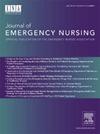Implementing “ER is for Emergencies” Practice Guideline to Reduce Nonemergent Emergency Department Visits
IF 2.3
4区 医学
Q2 EMERGENCY MEDICINE
引用次数: 0
Abstract
Introduction
More than half of all health care visits in the United States occur in the emergency department. These visits are the result of systems and policies that reduce primary care access. Patient linkage to primary care services is essential for improved health outcomes and effective emergency department care. This project aimed to implement a patient education and navigation program in a rural emergency department to reduce nonemergent emergency department visits and nurse workload and to improve patient enrollment in primary care patient-centered medical homes.
Methods
The project used a pretest-posttest design to determine the impact of the “ER is for Emergencies” clinical guideline on nonemergent emergency department visits and patient enrollment. The modified Need for Recovery Survey used a paired group analysis to assess the project’s impact on nurse workload and job satisfaction.
Results
A convenience sample of 38 primarily Black/African American (N = 35) and Medicaid-insured patients (N = 16) received nurse-led education and a referral to a patient-centered medical home. A comparison of pre- and postintervention chart reviews demonstrated a significant reduction in nonemergent emergency department visits after the intervention (P < .01) and improved participant enrollment in the patient-centered medical home (P = .04). Furthermore, the intervention was associated with reduced nurse-reported workload and stress (N = 7; P < .007).
Conclusion
The results of this quality improvement project are consistent with the broader literature that multimodal interventions can effectively reduce nonemergent emergency department visits and link patients to primary care. Multimodal interventions and policy solutions targeting structural inequities are urgently needed to support access to primary care and reduce nonemergent ED use.
实施“急诊室急诊”实践指南,减少非紧急急诊科就诊。
简介:在美国,超过一半的医疗保健就诊发生在急诊科。这些就诊是减少初级保健可及性的制度和政策的结果。患者与初级保健服务的联系对于改善健康结果和有效的急诊护理至关重要。该项目旨在在农村急诊科实施患者教育和导航计划,以减少非紧急急诊科就诊和护士工作量,并改善以患者为中心的初级保健医疗之家的患者登记情况。方法:本项目采用前测后测设计,以确定“急诊室为急诊”临床指南对非急诊急诊科就诊和患者入组的影响。修订后的康复需求调查采用配对组分析来评估该项目对护士工作量和工作满意度的影响。结果:38名主要是黑人/非裔美国人(N = 35)和医疗补助保险患者(N = 16)的方便样本接受了护士主导的教育和转介到以患者为中心的医疗之家。干预前和干预后的图表回顾比较显示,干预后非紧急急诊科就诊显著减少(P < 0.01),并改善了以患者为中心的医疗之家的参与者登记(P = 0.04)。此外,干预与减少护士报告的工作量和压力有关(N = 7;P < .007)。结论:该质量改进项目的结果与更广泛的文献一致,即多模式干预可以有效减少非紧急急诊科就诊并将患者与初级保健联系起来。迫切需要针对结构性不平等的多模式干预措施和政策解决方案,以支持获得初级保健和减少非紧急急诊科的使用。
本文章由计算机程序翻译,如有差异,请以英文原文为准。
求助全文
约1分钟内获得全文
求助全文
来源期刊
CiteScore
3.10
自引率
11.80%
发文量
132
审稿时长
46 days
期刊介绍:
The Journal of Emergency Nursing, the official journal of the Emergency Nurses Association (ENA), is committed to the dissemination of high quality, peer-reviewed manuscripts relevant to all areas of emergency nursing practice across the lifespan. Journal content includes clinical topics, integrative or systematic literature reviews, research, and practice improvement initiatives that provide emergency nurses globally with implications for translation of new knowledge into practice.
The Journal also includes focused sections such as case studies, pharmacology/toxicology, injury prevention, trauma, triage, quality and safety, pediatrics and geriatrics.
The Journal aims to mirror the goal of ENA to promote: community, governance and leadership, knowledge, quality and safety, and advocacy.

 求助内容:
求助内容: 应助结果提醒方式:
应助结果提醒方式:


